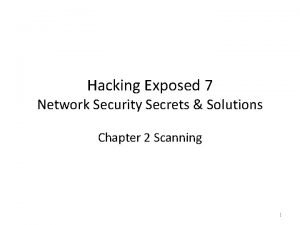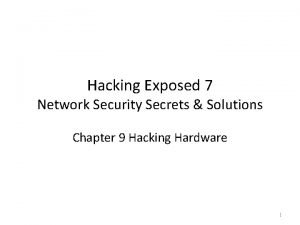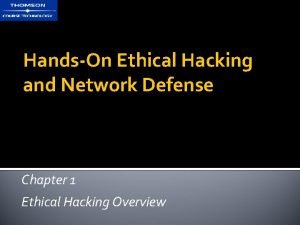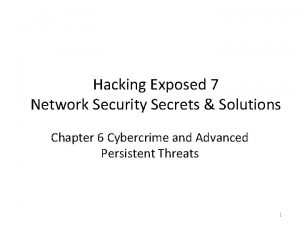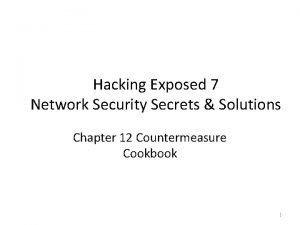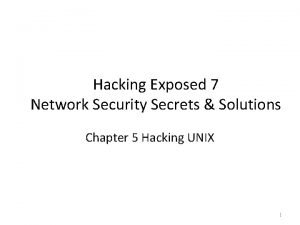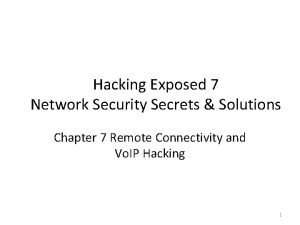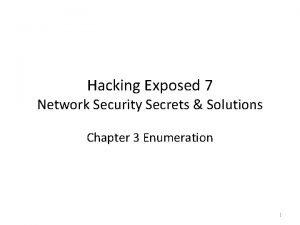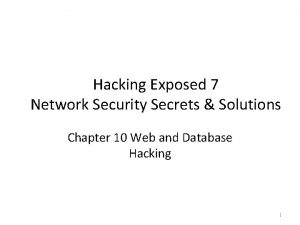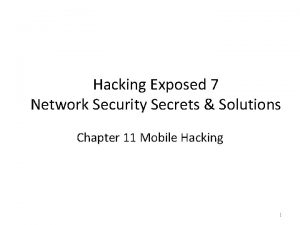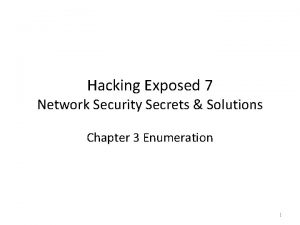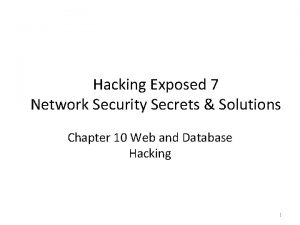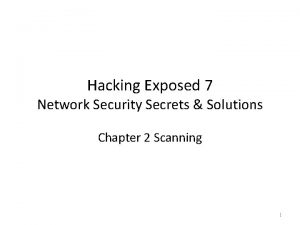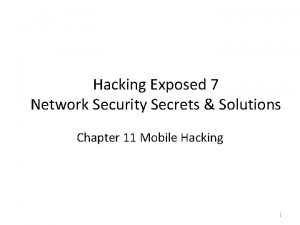Hacking Exposed 7 Network Security Secrets Solutions Chapter















- Slides: 15

Hacking Exposed 7 Network Security Secrets & Solutions Chapter 8 Wireless Hacking 1

Case Study on Wireless Hacking Read It and WEP (not Weep) • A store with the point-of-sale system connected through Wi-Fi /w WEP (Wired Equivalent Privacy) encryption • A hacker at the parking lot turns laptop with Wi-Fi card and directional antenna to promiscuous mode • aircrack-ng – airodump-ng to sniff 802. 11 frames including WEP initialization vectors (IVs) – Look for SSID (service set identifier) of interest and its MAC address – aireplay-ng to spoof as a client to capture ARP and replay it to collect enough IVs – aircrack-ng to crack WEP key from the capture file – Disable the promiscuous mode – Enter WEP key and get an IP address from the DHCP server 2

Background on IEEE 802. 11 Wireless LAN • Frequencies and channels – ISM (industrial, scientific, medical) unlicensed bands – 2. 4 GHz: 802. 11 b/g/n, channels 1 -14, non-overlapping channels: 1, 6, 11 – 5 GHz: 802. 11 a/n, channels 36 -165, all nonoverlapping • Session establishment – Clients scan channels, to send a broadcast probe request and wait for probe responses from APs with SSID (Service Set Identifier) • APs also broadcast beacons periodically • Windows Vista and later: clients wait for beacons – Clients send an authentication request to a selected AP – Clients send an association request to the AP 3

Security Mechanisms • Basic – MAC filtering: source MAC address pre-configured at APs – Hidden wireless networks: omitted SSID in beacons – Responding to broadcast probe requests: all pre-configured clients and APs, APs ignore any broadcast probe requests • Authentication: identity and encryption key – WPA-PSK (Wi-Fi Protected Access, Pre-Shared Key) • A 8~63 -ASCII-character PSK known by APs and clients to derive encryption keys – WPA Enterprise • Leverage 802. 1 x EAP (extensible authentication protocol) from clients to APs and extended to wired RADIUS server – Four-way handshake between clients and APs • Pairwise transit key (PTK) for unicast, group temporal key (GTK) for multicast/broadcast • Encryption: at layer 2 – Wired Equivalent Privacy (WEP) • RC 4, no real authentication to generate the key (known in advance) – Temporal Key Integrity Protocol (TKIP) • RC 4, a quick replacement to WEP – Advanced Encryption Standard (AES) 4

Equipments for Hacking • Wireless adapters – Chipset • Open hardware for re-written drivers allowing low-level control: Atheros, Ralink RT 73/RT 2770 F (merged to Mediatek), ref. : aircrack-ng. org – Band support • Both 2. 4 GHz and 5 GHz – Antenna support • External antenna for long-range attacks – Interface • PCMCIA being phased out, Express Card on laptop, USB with Virtual Machine, ref. : Ubiquiti SRC with Atheros on PCMCIA, Alfa with Ralink on USB • Operating systems: Windows Linux – Back. Track Linux distribution: preinstalled with all tools and drivers for all popular wireless adapters; run on VM, launch from a Live. CD on USB • Miscellaneous goodies – Antennas • Omnidirectional antenna with a wide focus and small gain, ref. : Hyper. Link. Tech, FABcorp, Pasadena Networks – GPS • To plot AP locations on a map, ref. : Garmin, Magellan – APs • To run Open. WRT or DD-WRT on some off-the-shelf APs 5

Discovery and Monitoring (1/2) • Finding wireless networks – Active discovery • Net. Stumbler: broadcast probe requests to get responses from APs • Many APs configured to ignore probe requests – Passive discovery • When APs are configured to not announce SSID or not to respond to probe requests • Listen to beacons to list BSSID (Basic SSID, i. e. , MAC address of the AP) and mark SSID as unknown • Listen to other clients talking to that BSSID to find the SSID – Discovery tools • • • War-driving to find APs War-flying with GPS to survey an area User-uploaded Wi. GLE. net: map of APs Kismet: support GPS-tracking, distributed deployment, GUI airodump-ng: part of aircrack-ng, simpler than Kismet Saved to PCAP files 6

Discovery and Monitoring (2/2) • Sniffing wireless traffic – Violation of law in some US states if neither party does not know – Many unencrypted wireless networks when difficult to do authentication: hot spots, airports, etc. – wireshark on Windows with Air. Pcap USB adapters – Thwarting wireless sniffing • WPA-PSK, WPA Enterprise • Upper layer encryption: VPN 7

Denial of Service Attacks • 802. 11 built-in mechanism: forced disconnect – Incorrect encryption key, overloading, etc. – Abused for Do. S attacks • De-authentication (deauth) attack – Spoof de-authentication frames to disconnect • From client to AP or from AP to client • Client drivers try to reconnect quickly • Send more than one deauth frame – airplay-ng: part of aircrack-ng • Deauth attack: 64 deauth to AP from client, 64 deauth to client from AP • Find SSID by observing client’s probe requests as it reconnects 8

Encryption Attacks • WPA vs. WEP – /w authentication vs. /wo authentication – /w key rotation vs. /wo key rotation – Crack again and again vs. crack once for all • WEP – Keystream • Generated by WEP key and IV (Initiation Vector, pseudorandomly generated for each frame and put into frame header) • TX: XOR plain text to get cipher text • RX: Use WEP key and IV from frame header to generate a keystream, XOR cipher text to get plain text – Duplicate IVs in two frames compare their cipher texts guess the keystream guess WEP key – ARP frames with little or no difference more duplicate IVs easier to guess the keystream and WEP key 9

Encryption Attacks Passive Attack • Capture enough data frames, parse IVs, deduce WEP key – 60, 000 IVs to crack a 104 -bit key • airodump-ng: capture to a PCAP file • aircrack-ng: analyze statistically on a PCAP file to get WEP key – Watch the rate at which IVs are collected to tell how much longer it will take to gather enough to crack the key – Stops with KEY FOUND 10

Encryption Attacks ARP Replay with Fake Authentication • Replay broadcast ARP requests – – From a client to an AP AP broadcasts with a new IV each time The client replays ARP and generates new ARP In 5 minutes, enough frames and IVs collected • Spoof a valid client’s MAC address – Fake authentication attack • Open authentication without sending actual data • Steps – airodump-ng: capture to a PCAP file – aireplay-ng: run fake authentication attack – Open another window to launch ARP replay attack with aireplay-ng again – aircrack-ng: crack on the captured PCAP file • WEP countermeasures: Don’t use WEP ever. 11

Authentication Attacks WPA PSK • About password brute forcing • WPA PSK – PSK shared among all users of a wireless network – Four-way handshake between clients and APs: Using PSK and SSID to derive encryption keys • PSK, 8~63 characters, hashed 4096 times with SSID • Trillions of guesses – Capture four-way handshake to crack PSK offline • Wait or deauth to kick a client off (its driver will reconnect) – Brute forcing • aircrack-ng with dictionary and PCAP • co. WPAtty: use SSID-specific rainbow tables (40 GB) – Use top 1000 SSIDs from Wi. GLE. net • Pyrit: offload hashing to GPU with multiple cores • WPA-PSK mitigating controls – Complex PSK and unique SSID – But could be disclosed by a single user 12

Authentication Attacks WPA Enterprise • Identifying 802. 1 x EAP (extensible authentication protocol) types – Capture EAP handshake – Wireshark shows EAP type – Unencrypted username in RADIUS server in EAP handshake • LEAP (lightweight EAP) – Cisco solution /w clear text MSCHAPv 2 challenge/response – asleep: offline brute-force attack with LEAP handshake and wordlist – Avoid using LEAP just like WEP • EAP-TTLS and PEAP – A TLS (Transport Layer Security, successor of SSL) tunnel between an unauthenticated client and RADIUS server • AP relays and has no visibility – Less secure inner authentication protocol often in clear text – AP impersonation and man-in-the-middle attack • Act as a terminating end of the TLS tunnel, if the client is misconfigured not to check the identity of RADIUS server access inner auth protocol – hostapd: Turn your card into an AP – asleep: offline brute-force on inner authentication protocol 13 – Countermeasure: Check the box to validate server certificate on all clients

Summary • WEP – Passive attack & ARP replay with fake authentication – Cracked in 5 min – Don’t use it! • WPA-PSK – Could be brute-forced, though high complexity – One PSK fits all put other users at risk • WPA Enterprise – LEAP • Could be brute-forced, needs extremely complex passwords • Don’t use it! – EAP-TTLS and PEAP • Relatively secure with multilayered encryption • Subject to AP impersonation and man-in-the-middle attack • Always have clients check server certificate 14

Homework #5 Ch 6 -8 (Total: 210) Due: 5/27 (Wed) in the class in printed hardcopy (format: problem, solution with explanation, screen dumps) 1. 2. 3. 4. 5. 6. 7. (30 points) Use all of WHOIS, Robtex, and Phish. Tank to trace back on a phishing email found in your mailbox. If you don’t find one, create one email account and post the email address onto Web to solicit some. Show and discuss your findings. (30 points) On Windows with some running processes connecting to the Internet, use FTK Imager to dump memory and then Volatility Framework to analyze the memory dump. Show processes with connections, and check whether they have DLLs. (30 points) Retrieve Poison Ivy RAT from the Internet. Use a program tracing tool you are familiar with to trace this RAT. Show you trace the RAT with your tracing tool and summarize what modules this RAT contains. (20 points) Use Nmap, NTA Monitor, IKEProbe to identify whether a target VPN server supports Aggressive mode. Screen dump “useful” results and explain. (20 points) Use Si. Vu. S, SIPVicious to scan a public SIP server. Screen dump “useful” results and explain. (30 points) Setup your own client and an AP, or find an existing AP, running no encryption. Use wireshark or airodump-ng to sniff and decode data frames. Show and discuss your findings. (50 points) Setup your own client and an AP to run WEP. Use the aircrack-ng suite to crack the WEP key by running through the steps of frame capturing, fake authentication attack, ARP replay attack, and key cracking. Show and discuss the steps you run through. 15
 Hacking exposed 9
Hacking exposed 9 Hacking exposed 9
Hacking exposed 9 Aldy bug
Aldy bug Hands on ethical hacking and network defense
Hands on ethical hacking and network defense Private securty
Private securty What is the osi security architecture
What is the osi security architecture Guide to network security
Guide to network security Wireless security in cryptography
Wireless security in cryptography Electronic mail security in network security
Electronic mail security in network security Security guide to network security fundamentals
Security guide to network security fundamentals Security guide to network security fundamentals
Security guide to network security fundamentals Unlocking the secrets of mohenjodaro
Unlocking the secrets of mohenjodaro The secrets to successful strategy execution
The secrets to successful strategy execution The secret of old ages
The secret of old ages Trade secrets examples
Trade secrets examples Definition of trade secrets
Definition of trade secrets
